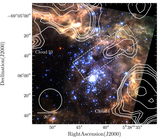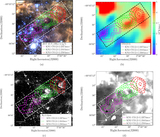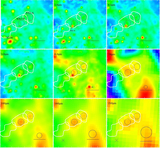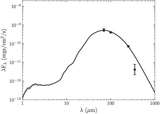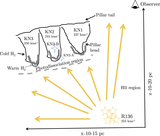Image Details
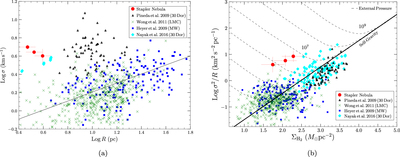
Caption: Figure 4.
(a) Relation between line width and size for CO(2–1) clouds identified near R136 (circles). The positions of clouds in the 30 Doradus region from Pineda et al. (2009) are shown as triangles, and green crosses mark clouds identified in the LMC by Wong et al. (2011). Cyan diamonds are data in 30 Doradus from Nayak et al. (2016). Blue squares are Galactic molecular clouds from Heyer et al. (2009), which follow the canonical relation of ﹩{\sigma }_{v}=0.72\,{R}^{0.5}﹩. (b) The ﹩{{\sigma }_{v}}^{2}/r-{{\rm{\Sigma }}}_{{{\rm{H}}}_{2}}﹩ relation of the stapler molecular clouds, plotted alongside results from the literature (symbols as in part (a)). The solid line gives the approximate ﹩{{\sigma }_{v}}^{2}/r﹩ value for increasing ﹩{{\rm{\Sigma }}}_{{{\rm{H}}}_{2}}﹩ of an isolated virialized cloud confined by self-gravity. The dashed lines mark the equilibria for external pressures ﹩P/{k}_{{\rm{B}}}\sim {10}^{3}\,\mathrm{to}\,{10}^{9}\,{\mathrm{cm}}^{-3}﹩ K of a centrally concentrated cloud approximated by hydrostatic equilibrium. The LMC clouds (including those in 30 Doradus) and Galactic molecular clouds appear confined by self-gravity, whereas the KN clouds require pressures ﹩\gtrsim {10}^{6}\,{\mathrm{cm}}^{-3}﹩ K to confine them. The large line widths therefore reflect the fact that the clouds are likely confined by external pressure.
Copyright and Terms & Conditions
© 2018. The American Astronomical Society. All rights reserved.


